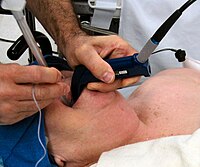
Photo from wikipedia
Objective: The aim of the study was to evaluate the feasibility of virtual reality (VR) software built using the core concepts of hand-arm bimanual intensive training (HABIT) for improving upper… Click to show full abstract
Objective: The aim of the study was to evaluate the feasibility of virtual reality (VR) software built using the core concepts of hand-arm bimanual intensive training (HABIT) for improving upper extremity motor function in children with cerebral palsy (CP). Methods: Eight children with CP participated in a 10-day, 40-hour HABIT program. Half of the time custom VR software, HABIT-VR was used. The children's motor skills were assessed pre- and postintervention with the Assisting Hand Assessment, Box and Blocks Test, and Nine-Hole Peg Test. Results: The children had significant and clinically relevant changes in the Assisting Hand Assessment and Box and Blocks Test; however, Nine-Hole Peg Test scores did not change with intervention. Conclusion: These data suggest that combining traditional HABIT strategies with HABIT-VR games improve upper extremity function and gross motor skills but not fine motor skills.
Journal Title: Pediatric Physical Therapy
Year Published: 2022
Link to full text (if available)
Share on Social Media: Sign Up to like & get
recommendations!